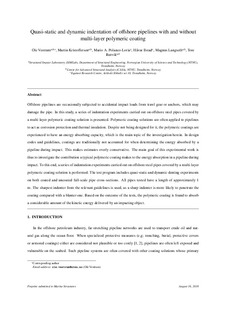| dc.contributor.author | Vestrum, Ole | |
| dc.contributor.author | Kristoffersen, Martin | |
| dc.contributor.author | Polanco-Loria, Mario | |
| dc.contributor.author | Ilstad, Håvar | |
| dc.contributor.author | Langseth, Magnus | |
| dc.contributor.author | Børvik, Tore | |
| dc.date.accessioned | 2018-09-05T07:02:39Z | |
| dc.date.available | 2018-09-05T07:02:39Z | |
| dc.date.created | 2018-08-27T12:48:55Z | |
| dc.date.issued | 2018 | |
| dc.identifier.citation | Marine Structures. 2018, 62 60-76. | nb_NO |
| dc.identifier.issn | 0951-8339 | |
| dc.identifier.uri | http://hdl.handle.net/11250/2560810 | |
| dc.description.abstract | Offshore pipelines are occasionally subjected to accidental impact loads from trawl gear or anchors, which may damage the pipe. In this study, a series of indentation experiments carried out on offshore steel pipes covered by a multi-layer polymeric coating solution is presented. Polymeric coating solutions are often applied to pipelines to act as corrosion protection and thermal insulation. Despite not being designed for it, the polymeric coatings are experienced to have an energy absorbing capacity, which is the main topic of the investigation herein. In design codes and guidelines, coatings are traditionally not accounted for when determining the energy absorbed by a pipeline during impact. This makes estimates overly conservative. The main goal of this experimental work is thus to investigate the contribution a typical polymeric coating makes to the energy absorption in a pipeline during impact. To this end, a series of indentation experiments carried out on offshore steel pipes covered by a multi-layer polymeric coating solution is performed. The test program includes quasi-static and dynamic denting experiments on both coated and uncoated full-scale pipe cross-sections. All pipes tested have a length of approximately 1 m. The sharpest indenter from the relevant guidelines is used, as a sharp indenter is more likely to penetrate the coating compared with a blunter one. Based on the outcome of the tests, the polymeric coating is found to absorb a considerable amount of the kinetic energy delivered by an impacting object. | nb_NO |
| dc.language.iso | eng | nb_NO |
| dc.publisher | Elsevier | nb_NO |
| dc.rights | Attribution-NonCommercial-NoDerivatives 4.0 Internasjonal | * |
| dc.rights.uri | http://creativecommons.org/licenses/by-nc-nd/4.0/deed.no | * |
| dc.title | Quasi-static and dynamic indentation of offshore pipelines with and without multi-layer polymeric coating | nb_NO |
| dc.type | Journal article | nb_NO |
| dc.type | Peer reviewed | nb_NO |
| dc.description.version | acceptedVersion | nb_NO |
| dc.source.pagenumber | 60-76 | nb_NO |
| dc.source.volume | 62 | nb_NO |
| dc.source.journal | Marine Structures | nb_NO |
| dc.identifier.doi | 10.1016/j.marstruc.2018.08.001 | |
| dc.identifier.cristin | 1604654 | |
| dc.relation.project | Norges forskningsråd: 237885 | nb_NO |
| dc.description.localcode | © 2018. This is the authors’ accepted and refereed manuscript to the article. Locked until 22.8.2020 due to copyright restrictions. This manuscript version is made available under the CC-BY-NC-ND 4.0 license http://creativecommons.org/licenses/by-nc-nd/4.0/ | nb_NO |
| cristin.unitcode | 194,64,45,0 | |
| cristin.unitname | Institutt for konstruksjonsteknikk | |
| cristin.ispublished | true | |
| cristin.fulltext | postprint | |
| cristin.qualitycode | 2 | |

